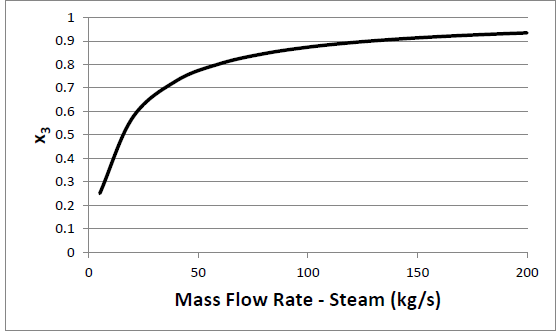Saturated liquid water at 200 kPa enters an insulated mixing chamber at a rate of 15 kg/s. The water is mixed with superheated steam at 200 kPa and 125oC. The combined flow will exit as a saturated mixture at 200 kPa. Using your mixing chamber model to calculate the data, plot the quality of the combined exit flow for superheated steam entrance flow rates ranging from 5 kg/s to 200 kg/s.
State 1: Liquid inlet; State 2: Steam inlet; State 3: Outlet
Given: P1 = P2 = P3 = 200 kPa; x1 = 0.0; T2 = 125oC; x3 = 1.0; m?1= 15 kg/s
Assume: Q?=0 (insulated). Given no other information regarding the mixing chamber, make the following common assumptions: W?=?KE=?PE=0
Also, assume the mixing chamber is a multiple-inlet, single-outlet, steady-state, steady-flow device.
Solution: The First Law for Open Systems reduces to.
m?1h1+m?2h2=m?3h3
The conservation of mass yields: m?1+m?2=m?3
For the water:
h1 = 504.68 kJ/kg
h2 = 2716.58 kJ/kg
The enthalpy at state 3 will depend on the superheated steam flow rate.
h3=m?1h1+m?2h2/m?1+m?2
Then x3 = (h3 – hf)/(hfg)
For the range of possible steam flow rates:

You might also like to view...
The box temperature of most medium temperature walk-ins is ________?
a. 15° b. 25° c. 35° d. 55°
____________________ is similar to equitation in that it is judged on the rider’s ability to ride and control a horse.
Fill in the blank(s) with the appropriate word(s).
When assessing chassis electrical system performance, where should you always begin?
A. batteries B. alternator C. cranking motor D. power distribution module
Birds are able to control their body temperature simply by adjusting or moving their feathers.
Answer the following statement true (T) or false (F)